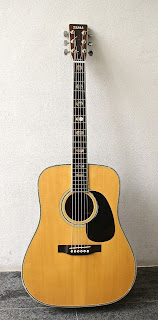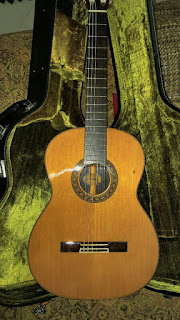Here a high end Sakurai guitar is presented which doesn't
look like the collaboration products between Orozco, Kohno
and Sakurai. Where this instrument has been produced
exactly, to my opinion Takamine. I have to inspect this
instrument in the near future. All solid materials? Rein-
forcement of the soundhole? Roses on the tuners a.s.o.
This is the model 7. Sakurai had the models 7, 10, 15 and 20.
A gracefully made heel anyway and
binding inlays on the sides as well.
The ebony reinforcement of the neck is missing here.
The fingerboard is made out of ebony and a nice rosette
completes this instrument. I havent heard it yet.... The
label is a bit like the Masaru Kohno labels. No coincidence
as Sakurai was the nephew of Masaru Kohno.
It appears to be decent fretwork but in fact
hard to conclude from the pictures of course
A rosette that differs from my recently bought Hirade model
15 guitar. But other details are convincing it to be from the
Takamine factories
The slanted short sides of the stringtie block aren't there
the way they are on the Kohno and Juan Orozco guitars.
And even another headstock that isn't even similar
to both the first and second headform on the Juan
Orozco guitar model 8, 10 and 15. No, it is similar
to the Hirade Master Arte models. And that confirms
them to be from the Takamine factories. A branded
Takamine stamp on the stripover the inner seam of
the two back halves might confirms that even more.
Just take a look at the beginning of this Blog to
learn more about all the existing connections.
TAMA TG 120
This is a TG120 Dreadnought from the second half
of the seventies. Simply great guitars soundwise.
Though the start was just copying the Martin D28,
this guitar has some alterations which makes it a real
TAMA product but more towards the Martin D41.
The way the first serie of Ibanez Artwood guitars
have been produced is already clearly visible. This
guitar has been built in 1978.
So these instruments are coming from the same factory
as the Juan Orozco, Masaru Kohno and Sakurai models
of that time. TAMA even launched classical guitars
under their own brandname that are in fact the same
instruments and most likely of the same quality.
I believe they even used the numbers 8, 10, 15 and 20
according to how Juan Orozco named his guitars
although Tama prefixed them with TC (Tama classical)
See for this part of information the unofficial site
of TAMA by Jurgen Hufschlag.
The TAMA company allready changed the head around 1976.
Ibanez later used this headform in their Artwood series.
The same factory - the same materials - the same high quality!
For the domestic market they used the brand "Bluebell".
Written on this allready small label is the name we more
than often saw in other labeled models "Asahi".
And soundwise I must confess here that I sold my
Martin D28 (1978) for this one. Simply better
sounding but people are aware of it nowadays.
Tama 3558S
This is an example of the first attempt to copy the Martin
D41 done in the Tama workshops. They also had a model
3558P that carries a plywood top. So here the S stands for
solid. Both sides and back are laminated. These models
already were very good quality wise but the second batch
simply was better in their (slightly) more complex sound.
At first glance a very well executed guitar but with a bit
too plastic looks to my opinion. Also the fretwork on
the later models was better.
But of course nice to look at though I tend to believe that
the Japanese firm didn't use real abalone for the inlay of
the edges. The fingerboard inlays however...
The headstock with the full name on it. Ibanez used the
name "Tama" as that was the name of the wife of the
president of the Ibanez company. Of course Ibanez
has everything to do with the Spanish Salvador Ibanez
company as they imported Spanish guitars at first from
them. The Spanish civil war and Second World War
forced the Japanese company to look for other sources.
And there was also attention for the back inlays.
The branded stamp which is a kind of a copy from the
Martin firm. Simple but so gracefully!
Tama TC-10 Guitar
Presented here is the Tama TC-10 constructed for the
world market and in fact not made in the Kohno workshop
as some people sometimes want to believe. Note the slanted
short sides of the bridge that can be seen on the Orozco
and Kohno guitars that are made in the same factory.
I've included this picture as here the varnished inner
part of the soundbox can be studied. Kohno followed
this procedure also for the instruments coming out
of his own workshop.
The central binding that simply is the same as on the
Orozco model guitars.
An ebony fingerboard and of course the simple Tama label.
The double ebony reinforced neck
And of course the roses engraved tuners though there
is a difference concerning the knobs: These are clinched
as opposed to the Orozco knobs. In fact a plus.
Most guitar players won't be aware about this highlight
in craftsmanship but the bindings are wood and so
meticulously done. Simply beautiful. The three fine
layers can be studied here and the Orozco model 10
is also equipped with the same binding purfling.
As becomes clear from the pictures here above, the
double ebony stripes are there as they are on the Juan
Orozco models 8, 10 and 15. But what's more, the
bracing is exactly the same as in the Orozco guitars.
I've got a 1982 Kohno 30 that I've had since it was new. It was a great guitar new, but it's matured into a very, very nice guitar. I think these instruments are currently undervalued, and I've seen them used around $3500 several times over the past year or so. That's probably about half what they're worth. If John Williams played one this fall, the price would probably go up to about $10,000 practically overnight. The only thing that I wish I could change on my guitar is that it's 660 scale--I'd prefer 650 or even 640. I've also got a Kenny Hill Hauser (USA) that's a 640 and it's a breeze to play, sounds great, and is plenty loud.
I have a price list from Dauphin Co. from April 1, 1982. It gives the following model information: Sakurai had the models 7, 10, 15, 20, these were re-named the 7, Standard, Excellent, and the Concert. They were made in the Kohno workshop under his supervision. "They are similar in all respects to the corresponding Kohno models". The model 20/Concert was the signature model. Prices at that time: 7, 780; 10, 1100; 15, 1560; and 20, 1800. The price list does not give any specifications on woods, etc. It is possible that Sakurai made other models that Dauphin didn't import or are not on the list as the Kohno models given are 20 (Concert), 30 (Professional), 50 (Special). I hope this answers some of your questions. (markhobson.net)

This is the guitar that turned me into a real guitar player. When I first started playing I was very fortunate to begin with classical training. I bought this guitar (made by Tama) in the early 70's and it has been a friend ever since. It has solid rosewood sides and back and a very fine spruce top. With a nice wide neck and relatively tall action it is exactly what a classical player needs. It can produce tones that range from subtle to powerful and from harsh to warm. To play Bach on this guitar borders upon a metaphysical experience. Absolutely a wonderful instrument.
On this picture the slanted short sides can be seen clearly.
And the roses of course on the tuners. Odd thing is that the
left and right placed tuners (3 in a row) differ from each other.
I have ever checked that with my Juan Orozco model 10 and
the same odd difference is there!
The TC-8 that surprisingly has the butterfly
tuning knobs as opposed to the Juan Orozco
8 model. Also this guitar seems to have an
ebony fingerboard. The Orozco 8 hasn't.
Carefully comparing this TC-8 with the
Juan Orozco model 10 we must conclude
they are exact the same model. Also the
Kohno labelled instruments carry a different
model numbering.
The Fleta style head.
Beautiful picture taken by Andre van Schoonderwoerd
den Bezemer who obvious is very glad with the purchase
of his Tama. He can be! Same qualities as the Orozco
model 10 though I must say it remains exemplary. E.g.
I was able to buy a model 15 as well but my model 10
simply sounded better! This is quite common on factory
produced instruments. In Korea they produced Fender
Stratocasters for a short time in the nineties. The quality
of these guitars simply was better than the more
expensive Mexican made ones! Those were the
Protone series which are worth searching for.
ik ben erg blij met deze gitaar. Ik vind de Tama heel veelzijdig, zowel klassiek als bij begeleiding voor zang. Flink veel volume en ook diep in de bas. Eerst dacht ik dat die dikke lak geen kenmerk was voor kwaliteit, echter deze Tama klinkt prachtig. Het viel me op dat ook de binnenkant gelakt is. Het is een massieve gitaar, echt een powerhouse. Als je er voor de grap met een plectrum een rockakkoord op slaat, dan overstemt 'ie met gemak de staal snarige broertjes. Het is werkelijk een beest van een ding. Maar ook lyrisch en zacht, met mee neuriënde boventonen.
Op de arme verweesde Tama zaten nog maar drie nylon snaren en de andere drie waren gebroken en zwart van de oxidatie.Pas toen ik 's avonds na een lange file eenmaal weer thuis kwam opende ik de koffer en kon heel rustig de Tama bekijken. Ik zette er nieuwe Savarez snaren op en later verlaagde ik de actie. De brug bleek van been en het topkammetje ook. Het stemmechaniek is heel solide en soepel. Inderdaad met die roosmotiefjes. Elke keer realiseerde ik me in toenemende mate dat deze Tama een behoorlijk goed instrument is. En dan wordt het magisch, toch?. want..
Weetje, ik klooide altijd maar wat aan op een oude countrygitaar en een gelamineerde Suzuki 36 uit 1977, ook niet slecht hoor.. maar dit! Ik weet niet wat me overkomt en wil sinds weken allemaal klassieke dingen leren. De Bourree van Bach zit er al in, en Un dia de Noviembre van Leo Brouwer ook, en nu probeer ik Diabelli's Andante Sostenuto. Ik kan geen noten lezen dus dat is allemaal flink puzzelen, maar ik heb een goed gehoor en ik kijk het af van Youtube. Deze Tama leert mij om goed en zorgvuldig te spelen. (Je kunt bij youtube instellingen de snelheid verlagen zonder toonhoogte verandering!)

































Geen opmerkingen:
Een reactie posten